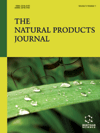- Home
- A-Z Publications
- Natural Products Journal, The
- Previous Issues
- Volume 13, Issue 3, 2023
Natural Products Journal, The - Volume 13, Issue 3, 2023
Volume 13, Issue 3, 2023
-
-
Ayurvedic Herbs and Spices: A Promising Approach for the Treatment of COVID-19
More LessAuthors: Ahsas Goyal, Aanchal Verma, Neetu Agrawal and Shilpi PathakSevere acute respiratory syndrome coronavirus 2 (SARS-CoV-2) is a novel coronavirus accountable for the coronavirus disease 2019 (COVID-19) that has led to many fatal cases worldwide. It causes a severe acute respiratory syndrome, a hyperinflammatory response, vascular damage, microangiopathy, and widespread thrombosis. Vaccines, interferon therapies, and small-molecule drugs may be among the various alte Read More
-
-
-
Mechanism, Pathophysiology and Herbal Management-A Review on Irritable Bowel Syndrome
More LessAuthors: Ankita Wal, Pranay Wal, Neha Verma, Awani K. Rai and Piyush VatshaBackground: The global distribution of IBS is surprisingly uniform, affecting men and women of all ages. Its deep-rooted character, symptoms that fluctuate from moderate to extreme, have several detrimental effects on the sufferer's standard of living; consequently, proper treatment of these patients is necessary. The etiology of IBS is unknown. Although several explanations were also proposed, the specific etiology of irritable Read More
-
-
-
Phytochemical, Pharmacognostic, and Pharmacological Aspects of Ricinus Communis Seed Oil: An Overview
More LessBackground: Castor oil is a multipurpose vegetable oil extracted from the seeds of the Ricinus communis from the family Euphorbiaceae. The castor oil contains a mixture of esters of saturated and unsaturated fatty acids such as ricinoleic, palmitic, stearic, oleic, linoleic, and linolenic acid linked to glycerol. The unique structure of major constituents of castor oil offers several functionalization possibilities for transforming it i Read More
-
-
-
In vitro Antioxidant Potential and In vivo Analgesic and Anti-Inflammatory Activities of Moroccan Equisetum ramosissimum
More LessAuthors: Saida Sissi, Loubna A. Dra, Soukaina Ouhaddou, Ouhammou Ahmed, Mustapha Larhsini and Mohammed MarkoukBackground: Equisetum ramosissimum is a pteridophyte plant used in Moroccan traditional medicine for its diuretic and antidiabetic properties. The species is known to reduce blood cholesterol levels and is given in cases of gonorrhea. Objective: The present work aims to explore the potential use of the crude butanolic (BE) and methanolic (ME) extracts of E. ramosissimum in the management of pain, inflammation and oxidativ Read More
-
-
-
Fats of Pigs of Different Breeds and Chemical Composition in the Diet of Animals
More LessBackground: The studies were carried out on quails, in the feed of which fat of various compositions was added. Objective: To establish the effect of adding fat from pigs of different breeds and vegetable oil to quail feed on their growth, productivity, and characteristics of lipid metabolism. Methods: Three groups of 60 chickens each were fed with vegetable oil (control) and fat of two pig breeds sharply differing in the chemi Read More
-
-
-
Chemical Composition, Antioxidant, Antimicrobial, and Immunomodulatory Activity of Mandragora autumnalis Grown in Jordan
More LessAuthors: Asma I. Mahmod and Wamidh H. TalibBackground: The activity of phytochemicals has a huge impact on pharmaceutical research and developing new drugs. Hence, numerous studies have been conducted to investigate the efficacy of different natural products and their potential to be used in different types of therapy. Objective: This study was carried out to investigate the biological activity of M. autumnalis crude extract and fractions, and the assessment include Read More
-
-
-
The Hepatotoxicity of Nigella sativa Oil Linked to the Route of Administration
More LessAuthors: Marwa El-Zeftawy, Doaa Ghareeb and Mahmoud BalbaaBackground: Even Nigella sativa oil (NSO) has several pharmacological effects; the route of administration is critical to obtain the desired activity in which intraperitoneal injection (IP) of oil recruits macrophages and induces inflammation. Objective: The current study aimed to determine the best administration route of NSO in rats either oral or IP. Methods: The components of NSO, routine blood analyses, hepatic oxidative stress a Read More
-
-
-
Sandwich Enzyme-linked Immunosorbent Assay (ELISA) to Quantify Monoclonal Antibody (B[a]P-13) for Herbal Medicine Products
More LessAuthors: Yong-Yeon Kim and Han-Seung ShinSandwich enzyme-linked immunosorbent assay (ELISA) to quantify monoclonal antibody (B[a]P-13). Background: Only a few studies have focused on the analysis using specific antibodies in the sandwich ELISA method to each B[a]P in herbal medicine products. In contrast to the sandwich ELISA method, many competitive ELISA methods using specific antibodies such as benzo[a]pyrene monoclonal antibody (B[a]P-13) and a goat Read More
-
Most Read This Month
Article
content/journals/npj
Journal
10
5
false
en


